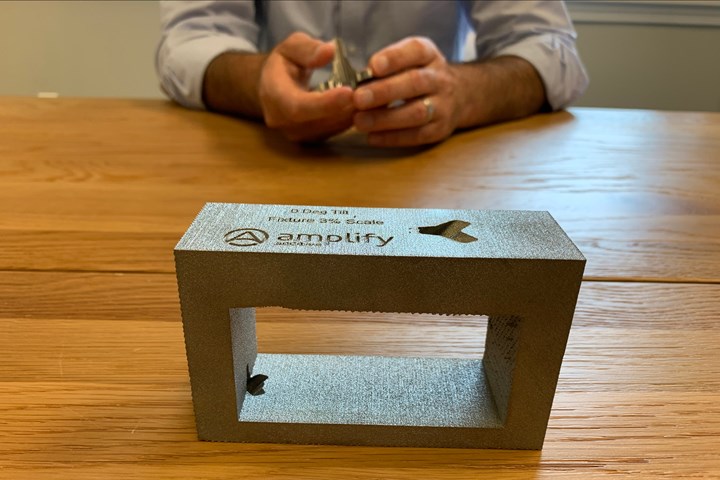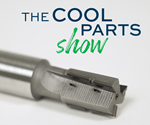With This 3D Printed Block, EBM Is an Aid to CNC Machining
Holding the part is a challenge of machining for additive manufacturing. This medical manufacturer prints fixture tooling tailored to its additive parts.

This fixture tool for holding additive manufactured parts for machining was made within the same EBM build as the parts themselves.
Production metal parts made via additive manufacturing (AM) need CNC machining as a secondary step. This point is practically universal. CNC machining can produce close-tolerance features such as threaded holes and flat mating surfaces that are too precise for 3D printing. The metal removal needs are often slight in AM, but the machining can be difficult nevertheless because of the challenge of holding and positioning the organic-shaped additive part.
Amplify Additive had this challenge with orthopedic implants made via electron beam melting (EBM — the metal AM technology from Arcam, now part of GE Additive). Or, more accurately, its machining supplier had this challenge. Engineering setups to hold the complex parts Amplify sent it would introduce lead time delay. In one extreme case (partly a result of disruption related to covid), Amplify faced a lead time of four months on machining work from this shop, which is more than 100 times longer than the lead time the 3D printing requires.
To help, Amplify has begun to design and 3D print the fixture tooling for machining in parallel with the implants and provide both to the machine shop. The photo shows an example. The long stem of an implant fits through the precise opening in the top face of this block and is secured within the notch in the inner corner. The visible “3%” figure refers to these features being oversize by that amount relative to the AM part. This margin, plus the positioning of these features, orients the part precisely to present the surface in need of machining to the machine tool’s spindle.
This seemingly simple tool also shows off some of the advantages of electron beam melting. The high-temperature process (hotter than laser powder bed fusion) reduces thermal stress, making it easier to print a square form useful for setup on a machine tool. Also, EBM is a process with less need for support structures than laser powder bed fusion, which in this case allowed Amplify to simply add this tool to one of its builds and send the tool to the machine shop in its as-printed form.
Related Content
-
Jeol’s Electron Beam 3D Printer Meets Aerospace Qualification Standard
The company says that meeting the AMS7032 operational qualification standard ensures manufacturers that Jeol’s JAM-5200EBM is capable of producing aerospace-grade material with stable performance and meets all material specification requirements.
-
VBN Components Offers High-Performance Materials Development as a Service
Formnext 2023: VBN Components is exploring new possibilities in metal materials development, including promising prospects with hard metals and refractories.
-
Video: What Is Electron Beam Melting (EBM)?
Electron beam melting is the higher-energy metal 3D printing process offering advantages when it comes to productivity and thermal stresses. Here is an introduction to EBM.












